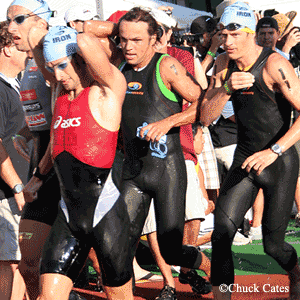Are Speedskins a viable product category?

Blue Seventy has established a clear lead in the "speedskin" category, with its suits on one out of every three of Kona's participants at the most recent Hawaiian Ironman. By way of perspective, for every four Cervelos in the Kona field there were seven Blue Seventy PZ3s.
Next closest to Blue Seventy's 601 (count 'em) speedskins was Zoot with its 101 skins. XTERRA and 2XU had 52 and 50 of speedskins respectively, followed by Sailfish with 22 and Orca with 10.
Sailfish is the German wetsuit company owned by überswimmer Jan Sibberson, the erstwhile XTERRA distributor who broke off and now has his own brand (much like XTERRA's founder Keith Simmons broke off from Ironman wetsuits to form his brand).
Still an open question is whether this is a viable category, or a Kona-only phenomenon that may itself be an imperiled product.
One manufacturer we spoke to said it sold 1000 of these units in 2007 — not bad for a first year product, but not yet enough to be considered a successful product category. The retailers to whom the product sold consisted of the big mail order sellers plus retailers in Florida and stores close to the warm water found in Gulf States.
The problem is that the 78° temperature cut-off for age-groupers make most swims wetsuit legal. The upcoming Ironman Florida, for example, may be wetsuit legal for age-groupers and illegal for pros, meaning the 70 pros will wear their speedskins — most of which are given them — whereas the age-group field of 2000 will wear their wetsuits.
Also in question is whether the Hawaiian Ironman will allow them at all for next year's race. The betting line, for those in the know, has gone from 70/30 in favor of banning them to 50/50. A decision is possible and perhaps even likely during the month of November, according to one closely placed source.
Regardless of what the Ironman does, these suits are very much here to stay for USA Triathlon races outside of the Hawaiian Ironman. Even if Kona bans them, they are likely to be allowed in other Ironman and 70.3 races where wetsuits are not legal, such as the Clearwater 70.3 Championships. And, you can add many late summer Midwest swims to the age-group wetsuit-illegal column, including the occasional USAT National Championship.
But how many people will buy these suits? The time benefit granted a swimmer in such a suit is incremental compared to the large speed benefit a wetsuit grants. On the other hand, the time savings of such a suit may arguably equal that of an aero wheel.
Is this a market where more than 10,000 per year will be sold by all the manufacturers combined, or is it in the 50,000 to 75,000 neighborhood — a fair guess of the size of the annual tri wetsuit market? That's the question not yet answered.

